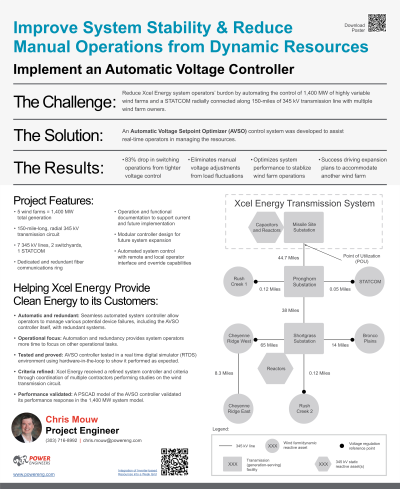Back

Managing Growth
Improve System Stability & Reduce Manual Operations from Dynamic Resources: Implement an Automatic Voltage Controller
Tuesday, September 12, 2023
4:30 PM - 5:30 PM PDT
Location: Poster Area, Booth #11024, Level 1, Venetian Expo Hall


Chris Mouw (he/him/his)
Senior Project Engineer
POWER Engineers
Hailey, Idaho, United States
Poster Presenter(s)
The variable nature of wind, coupled with a long transmission line and the characteristics of inverter-based generation, can lead to undesirable reactive power swings as the generation ramps up and down. Such is the case at Xcel Energy’s Rush Creek Gen Tie, a 150-mile-long radial 345 kV line that receives power from five interconnected wind farms in eastern Colorado. The utility wanted a better way to manage the efficiency and stability of this complex radial system, so they teamed with contractors to design an automatic, coordinated voltage control system for the wind farm transmission system. Called an Automatic Voltage Setpoint Optimizer (AVSO), this control device performs voltage adjustments that would otherwise be performed manually to improve the power factor and to reduce the risk of significant or oscillatory reactive power swings among the wind farms. The 345 kV switched fixed capacitor banks at the Missile Site Substation saw an 83% reduction in switching operations after the AVSO was placed in service, which is reducing costs, improving reliability and increasing resiliency. Top Takeaways 1. Developing and implementing the AVSO demonstrates how engineering problems can be addressed as integrating inverter-based resources become more widespread at the utility scale. 2. Reduction in high-voltage cap bank operation is expected to yield cost savings through increased intervals between breaker maintenance and prolonged equipment life. 3. Implementing the AVSO also included savings in operational maintenance costs and reducing operators’ routine workloads, freeing them to focus on critical and unplanned system events.
